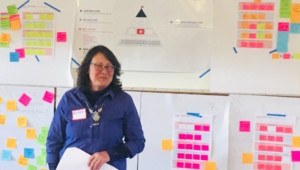10 Shifts that Change Everything
 Change forces and market drivers (described in 3×5 revolution) are finally bringing the digital revolution to education. Online learning is creating new options for students. Blending online and onsite learning has the potential to improve learning and operating productivity. The digital learning revolution is creating 10 shifts int he way we learn (first explored in a 7/3 post)
Change forces and market drivers (described in 3×5 revolution) are finally bringing the digital revolution to education. Online learning is creating new options for students. Blending online and onsite learning has the potential to improve learning and operating productivity. The digital learning revolution is creating 10 shifts int he way we learn (first explored in a 7/3 post)
1.Responsibility. Families are taking back responsibility for learning and choices in learning are exploding. In America, most states grant charters to nonprofit groups to operate independent schools. New York City closed 90 failing schools and invited community organization to assist in developing 400 new schools. Independently run government funded education is common in Europe, Scandinavia, and Chile. Low cost private schools provide educational options in India and Africa.
Higher learning choices are expanding; and while traditional college costs spiral higher, some new options like Open University are free, and some are very low cost. Competency-based programs like Western Governor’s University give credit for demonstrated expertise. Straighter Line allows students to earn college credits on an accelerated basis for $99 per month.
2.Expectations. The standards movement, culminating in the Common Core,[iii] reflects American political consensus that all students should be eligible and prepared for higher learning—a monumental step for equity but with the unintended consequence of standardizing a 19th century version of schooling based on age cohorts, credit hours and bubble sheet tests.
A generation that has grown up with the ‘my way’ mindset expects more customization than a lecture hall can offer. While more people are attempting higher learning, less than 10% take the typical path and finish a four year degree immediately after high school. The challenge of the coming decade is combining a commitment to ‘success for all’ with the need for ‘individual pathways for all.’ New informal learning options—games, virtual environments, and simulations—do this well. Individualized school models like Big Picture and Kunskapsskolan provide individual pathways despite a restrict policy environment. The innovation opportunity is new learning formats that nurture individual needs, interests, and learning modalities. The bottom line: we won’t achieve ‘success for all’ until we have pathways for all.
3.Aspirations. Most developed countries give content-based tests at the end of high school to limit enrollment into higher education. Cheap standardized tests provide high reliability but don’t have much to do with future success. The Partnership for 21st Century Skills and a number of foundations argues that critical thinking, communication, and learning to learn is far more important than disciplinary knowledge. Critics argue that discipline knowledge is critical to critical thinking.[iv] It seems clear that the ability to create, perform and persist under dynamic circumstances will be the most important skills. In the Free Agent Nation, the ability to learn and to manage a project will produce big dividends.
4.Content.The adoption of textbooks is the retained fallacy of school boards that they control content and instruction. We passed the point of no return on content control in 1994 when the Internet exploded. While there is value in curated content, textbook adoption is a silly and expensive relic. With well defined learning expectations, the killer application of the coming decade is the smart recommendation engine that queues content based on learning level, interest and best learning modality. Next generation learning platforms will combine open and proprietary content—learning objects, lessons, and units—with learner and teacher services.
5.Pedagogy. Didactic learning works for some motivated and well-supported students. Teacher centered, lecture-based classrooms are giving way to student-centered, interactive, applied, and project-based learning. Master schedules will give way to interesting blends of playlists and projects.
6.Assessment. The most important shift of the coming decade may be the instant feedback of content–embedded assessment. As student learning shifts to predominantly digital, there will be a flood of keystroke data from games, simulations, virtual environments, end of unit quizzes, and adaptive assessments.
Some individual progress models will be enabled by merit badges—competency clusters demonstrated by content-embedded assessment and performance assessment (i.e., science projects, papers, videos). First made prominent by Rich DeLorenzo in Chugach Alaska, merit-badge approaches will provide a motivating visual pathway for learning with multiple forms of performance feedback.
7.Grouping. The age-cohort model where students of the same age slog through a print curriculum at the same rate is slowing giving way to individual progress models where students learn at their own rate. Individual progress models—common in alternative education, online learning and credit recovery—will become most prominent in high school, community college, and certificate programs.
8.Location. School formats that blend the best of online and onsite learning will increasingly incorporate community assets. Like Tacoma School of the Arts, blended schools will use museums, theaters, and universities for meeting space. Like Big Picture, internships will become more commonly a part of a high school learning experience. Learning will take place anytime, anywhere.
Students in high school and college will increasingly assemble a transcript from multiple providers. Their formal certification may be place-based, but their education will be unbounded.
9.Culture. Most big high schools have a student-driven culture—while administrators won’t admit it, the kids run the show. In good schools, leaders create an intentional culture around productive aims and norms. Online, blended, and community-connected learning develops a mixed-aged culture—old teaching young, young teaching old, peer-tutoring.
10. Relationships. Social networks will augment and then replace classroom as the dominant organizing unit of learning. While many students will matriculate at their own rate, they will do most of their learning as part of a virtual community.
The following table summarizes the 10 shifts from what was to what is to what is to come.
| Factor | From | To | To |
| Responsibility | Parents | State | Individuals/parents |
| Expectations | Social reproduction | Success for all | Individual choice |
| Aspirations | Practical sills | Disciplinary knowledge | Learning how to learn |
| Content | Books | Textbook | Learning objects |
| Pedagogy | Apprenticeship | Didacticism | Interaction |
| Assessment | Observation | Testing | Embedded assessment |
| Grouping | Mixed-age | Age cohorts | Individual progress |
| Location | Home | School | Anywhere |
| Culture | Adult culture | Peer culture | Mixed-age culture |
| Relationships | Personal bonds | Authority figures | Social networks |
(Adapted from Rethinking Education in the Age of Technology, Collins & Halverson)





0 Comments
Leave a Comment
Your email address will not be published. All fields are required.